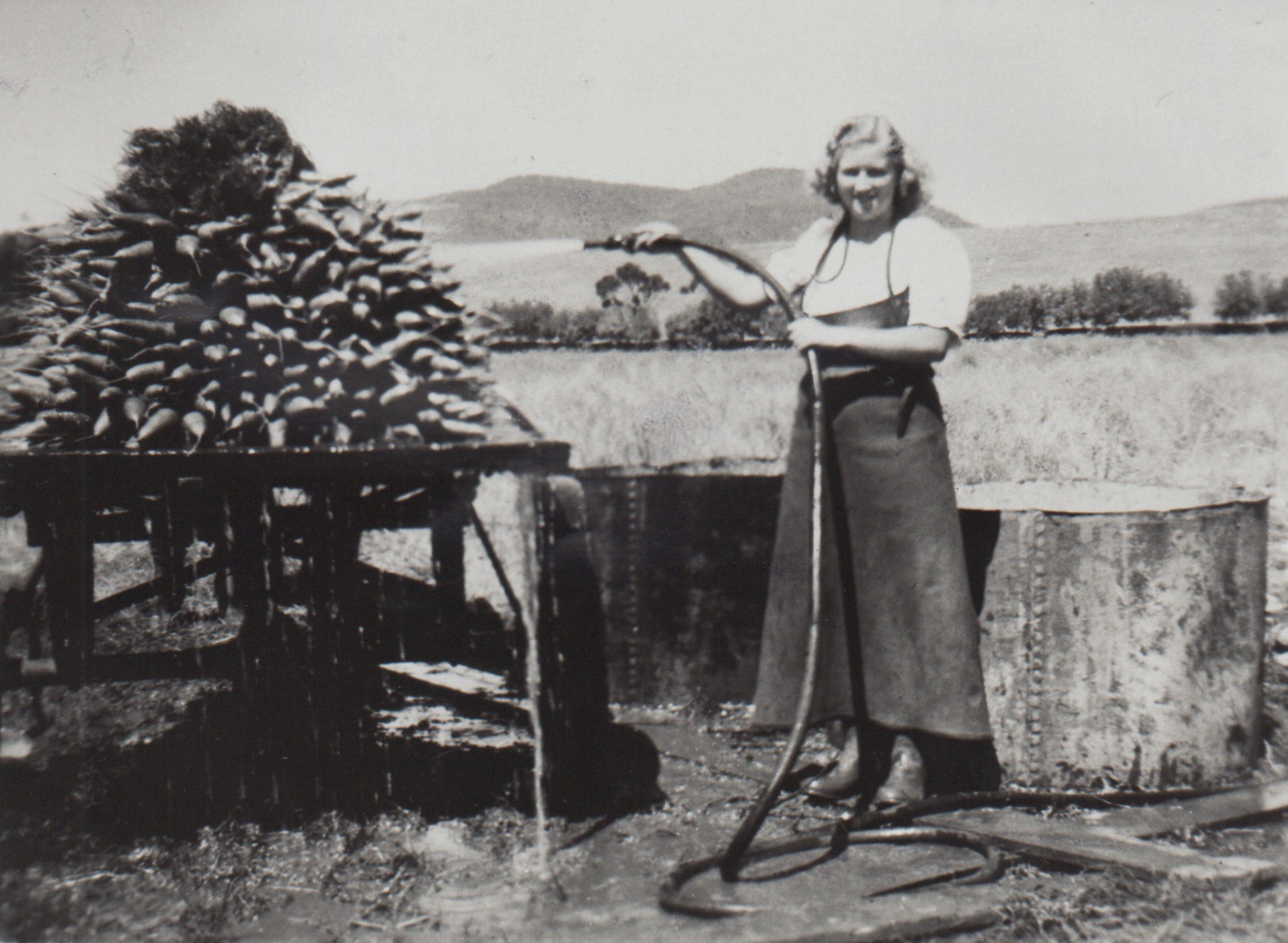Market Gardening in WWII
Before World War II Campbelltown, South Australia, was a sleepy agricultural community of less than 5,000 people (Commonwealth of Australia, 1933), on the north-eastern outskirts of Adelaide. The main industries were market gardening and mixed-farming. Mechanisation was slow in coming and many smaller farms still ploughed the land using horses. (Warburton, 1986)
When World War II commenced the young men who worked on the market gardens were quick to answer the call to service, and more than 1,500 men and women from the District joined the armed forces. (Australia. Department of Veterans' Affairs.) This left the gardeners with a serious labour shortage, just when self-sufficiency in food production was becoming critical for Australia. ("Vegetable drive here has begun" in "The News" (Adelaide, SA), 1943)
At the same time as the young men were leaving the land to join the armed services or to take up war industry jobs in the factories, women were looking for a way to contribute to the war effort. The Australian Women's Land Army began as a grass-roots movement among local women. The Commonwealth Government did not formally recognise the movement until 1942, by which time about 700 South Australian women had already been placed in seasonal rural work. (Hardisty, 1990)
"On one property, belonging to the Hutchinson family, near Athelstone, as many as 12 women have been working daily gathering in and tapering swede turnips for a military contract, packing onions in crates and picking beans." ("Pulling onions in Athelstone" in "The Mail" (Adelaide, SA), 1941)
The work was hard physical labour and the pay was only a nominal sum that did not constitute a living wage. (Hardisty, 1990)

Photo: Dulcie Silke, Australian Women's Land Army, Paradise, S.A., 1940s. Courtesy of Mrs Peggy Hicks (nee Silke), Melbourne.
"We worked for Mr Hobbs... in his market garden in Paradise, picking and packing celery. He used to grow it beautifully. Half past seven on a cold frosty morning the celery had to be all washed by hand, packed and sent to Victoria. That was pretty hard work... [Later on] there was a factory opened up at Hectorville, just several miles down the road from my parent's home, where we lived. I think it was called the Robson-Jarvis factory and they had olive groves. We picked olives and then we had to pickle and pack them in the factory. They started dehydrating potatoes and apples for the troops and we were also put on this." Win Tregonning. (Hardisty, 1990)
In addition to the women of the Land Army, there was a sizable Italian immigrant community of about 100 people living in Campbelltown (Commonwealth of Australia, 1933), plus Italian seasonal workers from other Districts, who were excluded from joining the armed forces unless they were naturalised citizens. (D'Angelica, 1985) The Italian community suffered serious discrimination when Italy joined the Axis powers in 1940. Some gardeners refused to employ Italian labourers during wartime, but others stood by their Italian workforce. (Warburton, 1986)
"During the war, Australian workers threatened to go out on strike and expel me...[Mr] Wicks wouldn't budge and kept me on." (Cerritello, 1985)
Even with the assistance of the Australian Women's Land Army and the local Italian community, gardeners were struggling to find a large enough workforce to harvest their crops. In 1943, the Commonwealth Government agreed to allow select Italian Prisoners of War to work on farms in the Adelaide Hills area, including Campbelltown, as the fascist government in Italy had recently been defeated. (Fitzgerald, 1981)
Many of those who were sent to work in the market gardens as Prisoners of War, chose to return to Australia after being repatriated to Italy, and went on to sponsor the immigration of relatives and friends. (Dilena, 1985) Land ownership rules were relaxed and Italian immigrants started to buy land in Campbelltown. (Cerritello, 1985)
"[a relative who] had been brought to Australia as a prisoner of war and had worked on the farm... then returned to Sicily, but came back to Australia in the early 1950s, called [back by the farm's owner], he in turn called various relatives..." (Dilena, 1985)
Campbelltown was changed forever by the Second World War. A vibrant Italian-Australian community was firmly established, and because of the rapidly growing post-war population the market gardens have gradually disappeared beneath the urban sprawl.
If you have any comments or questions regarding the information in this local history article, please contact the Local History officer on 8366 9357 or hthiselton@campbelltown.sa.gov.au.
References
- "Pulling onions in Athelstone" in "The Mail" (Adelaide, SA). (1941, January 25). Retrieved April 22, 2015, from Trove: http://nla.gov.au/nla.news-article55761991
- "Vegetable drive here has begun" in "The News" (Adelaide, SA). (1943, February 10). Retrieved January 5, 2016, from Trove: http://nla.gov.au/nla.news-article128332115
- Australia. Department of Veterans' Affairs. (n.d.). Place Search. Retrieved May 16, 2022, from World War 2 Nominal Roll: https://nominal-rolls.dva.gov.au/ww2#PlaceSearch
- Cerritello, M. (1985). Italians in Campbelltown. (E. Warburton, Interviewer)
- Commonwealth of Australia. (1933, June 30). Australian Bureau of Statistics. Retrieved January 11, 2016, from 2110.0 - Census of the Commonwealth of Australia, 1933: http://www.abs.gov.au/AUSSTATS/abs@.nsf/DetailsPage/2110.01933?OpenDocument
- D'Angelica, C. (1985). Italians in Campbelltown. (E. Warburton, Interviewer)
- Dilena, V. (1985). Italians in Campbelltown. (E. Warburton, Interviewer)
- Fitzgerald, A. (1981). The Italian farming soldiers: Prisoners of War in Australia 1941-1947. Carlton (Vic.): Melbourne University Press.
- Hardisty, S. (. (1990). Thanks girls and goodbye!: the story of the Australian Women's Land Army 1942-45. Ringwood (Vic.): Viking O'Neil.
- Warburton, E. (1986). From the river to the hills: Campbelltown 150 years. Campbelltown (S. Aust.): Corporation of the City of Campbelltown.
